What Is a Radiator, and Why Is It So Important for Your Vehicle?
When it comes to your car, the radiator plays a vital role in keeping everything running smoothly—literally! But what exactly is a radiator, what does it do, and how can you tell if there’s a problem? Let’s break it down in simple terms.
What Is a Radiator and What Does It Do?
Think of the radiator as your car’s cooling system superhero. Its job is to regulate the engine’s temperature, preventing it from overheating or freezing up, depending on the season. When your engine runs, it generates an incredible amount of heat. If left unchecked, this heat could damage critical components, leading to costly repairs.
Here’s how the radiator keeps your engine cool:
- Coolant Circulation: The radiator circulates a liquid called coolant (a mixture of water and antifreeze) through the engine.
- Heat Absorption: As the coolant moves through the engine, it absorbs excess heat produced by the combustion process.
- Heat Release: Once the coolant becomes hot, it flows back to the radiator, where air passing through the radiator’s fins cools it down.
- Repeat Cycle: The cooled liquid then cycles back into the engine to absorb more heat, and the process continues.
Without a properly functioning radiator, your engine wouldn’t be able to maintain the right temperature. It could overheat in the summer or freeze in the winter, leading to major mechanical issues.
Below is a simple diagram of how a radiator is connected to the rest of your vehicle. The heat generated from the radiator is expelled via the cooling fan and antifreeze is used to transfer the heat throughout the car. This works exactly like a radiator would in older homes. What we won’t cover in this blog post is how the radiator is used for A/C. More on that in another post!

What Does Antifreeze Do?
Antifreeze is a crucial component of the coolant mix. It prevents the liquid from freezing in cold weather and raises its boiling point so it won’t evaporate in extreme heat. This dual-purpose function allows your radiator to protect your engine in all seasons.
In winter, antifreeze keeps the coolant liquid and flowing, even when temperatures drop well below freezing. Without it, the coolant could freeze inside the engine or radiator, potentially cracking important parts.
How Can You Tell If There’s a Radiator Issue?
Radiator problems can happen for several reasons, from wear and tear to lack of maintenance. Here are the most common signs of trouble and what to look for:
- Engine Overheating: If your temperature gauge shows the engine is running hot or a warning light comes on, it’s often a sign the radiator isn’t working properly.
- Coolant Leaks: Look for puddles of green, orange, or pink liquid under your car. This often indicates a coolant leak from the radiator or hoses.
- Sweet Smell: A sweet smell coming from under the hood might mean coolant is leaking onto a hot engine part.
- Low Coolant Levels: You may notice a warning light on your dashboard, often shaped like a thermometer or labeled “coolant.” You can also check the coolant reservoir under the hood; if the liquid is below the “minimum” line, it’s time to top it off.
We’re Here to Help!
At Toronto Mobile Mechanics, we understand that these radiator issues are unexpected and could be a frustration —especially in the middle of a freezing Canadian winter. That’s why we offer convenient, on-site services right at your doorstep.
Whether you need a radiator inspection, repairs, or just want to make sure your antifreeze and other parts of your car are in good, running condition — our team of experts have you covered.
Contact us at 647-299-6077 or email us at info@torontomobilemechanic.ca


Recent Comments